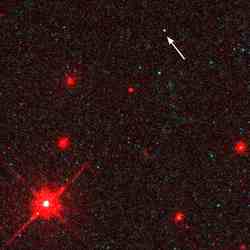
NASA’s first look at a lonely neutron star. Image credit: NASA/HST Click to enlarge
The most powerful explosions in the Universe are the mysterious gamma ray bursts, which astronomers now think are collisions between neutron stars. A new simulation has calculated that in the moments after a collision, the explosion generates a magnetic field 1000 million million times more powerful than the Earth’s magnetic field – the strongest magnetic fields in the Universe. The simulation took weeks on a supercomputer to calculate just a few milliseconds of a collision between neutron stars.
Scientists from The University of Exeter and the International University, Bremen have discovered what is thought to be the strongest magnetic field in the Universe. In a paper in the journal Science, Dr Daniel Price and Professor Stephan Rosswog show that violent collisions between neutron stars in the outer reaches of space create this field, which is 1000 million million times larger than our earth’s own magnetic field. It’s thought that these collisions could be behind some of the brightest explosions in the Universe since the Big Bang, so-called short Gamma-ray bursts.
Dr Daniel Price, of the School of Physics at The University of Exeter, said: “We have managed to simulate, for the first time, what happens to the magnetic field when neutron stars collide, and it seems possible that the magnetic field produced could be sufficient to spark the creation of Gamma-ray bursts. Gamma-ray bursts are the most powerful explosions we can detect but until recently little to nothing has been known about how they are generated. It’s thought that strong magnetic fields are essential in producing them, but until now no one has shown how fields of the required intensity could be created.”
He continues: “What really surprised us was just how fast these tremendous fields are generated – within one or two milliseconds after the stars hit each other.”
Prof Stephan Rosswog, of the International University, Bremen, Germany, adds: “Even more incredible is that the magnetic field strengths reached in the simulations are just lower limits on the strengths that may be actually be produced in nature. It has taken us months of nearly day and night programming to get this project running – just to calculate a few milliseconds of a single collision takes several weeks on a supercomputer.”
The remnants of supernovae, neutron stars are formed when massive stars run out of nuclear fuel and explode, shedding their outer layers and leaving behind a small but extremely dense core. When two neutron stars are left orbiting each other, they will spiral slowly together, resulting in these massive collisions.
Original Source: University of Exeter
